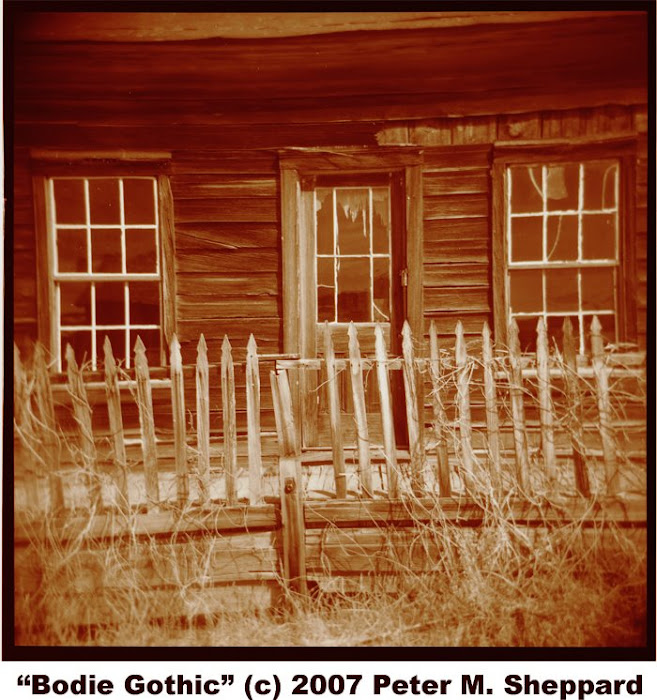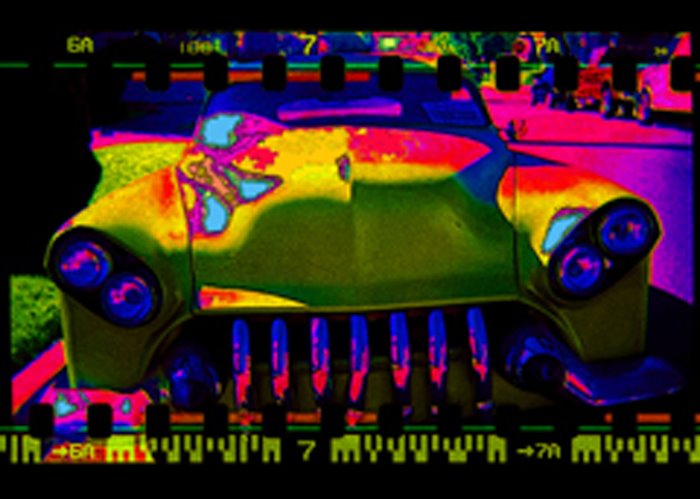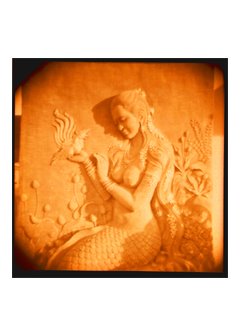"So here's how focusing works... the picture of the single person is for taking portraits, the picture of the three people is for family pictures, the picture of the bunch of people is for group shots and the picture of the mountain is for landscapes!"
A quote from a You Tube video explaining the Holga 120N camera...
Er... uh, yeah... RIGHT!
Okay, so I have been seriously shooting this "Drastic Little Piece of Plastic" for going on 3 years now and I have never gotten the skinny on these little symbols on the barrel of the lens! Everywhere I turned I got misinformation. The booklet that comes with the camera says one thing, the pamphlet put out by the Lomographic Society says something else and the $25 book written by the Holga expert says bupkiss about focusing! So, not being one to shy away from a great opportunity to experiment I have to, in the words of the late, great W. C. Fields, "Take the bull by the horns and get behind the situation!"
Firstly, lets consider what the experiment would entail: mounting the camera to a tripod so every shot was exactly the same; using a slower, and sharper film than 400, (I used an out-of-date roll of 120 160NC from Kodak); and leaving the 6x6 film plane mask in the camera to ensure the sharpest picture possible, (hey, it's a Holga, after all!)
Secondly, I needed to determine what the actual symbols meant before I could test them. Reading extensively and gleaning what I could from various articles, books and You Tube videos still didn't give me the correct information I needed for my experiment. So, I used what I considered the best information - the pamphlet that came with the camera - and considering the metric system is what they use in China, I went with these numbers. Next, I got on the Internet to find a "feet-to-metric" conversion chart to come up with the actual measurements, not the "fudged" numbers they put out as a conversion from metric to feet.
Also, I wrongfully determined that the symbols represented an exponential focusing factor for the simple plastic meniscus lens! What that means is the "field of focus" on the first symbol on the barrel of the lens is doubled the length of focus on the second symbol. So, going by this determination if the first symbol is 1 meter, or 3.3 feet, then the second symbol is double the distance, or 6.6 feet. However, that isn't the case here. The maker of this camera had some great features, despite the crappy frame!
Using the online conversion chart I came up with the following approximate values:
1 person/short field of focus = 3.3 feet (1 meter)
3 persons/semi-medium field of focus = 6.6 feet (2 meters)

large group/medium field of focus = 19.75 feet (6 meters)

mountains/infinity field of focus = 33 feet (10 meters) to infinity
So, you can see as I did that there doesn't seem to be any rhyme or reason to the focusing numbers. But there is a simple explanation: if you look at the barrel of the lens the plastic label for the symbols has a little extra space between the 2nd and 3rd and 3rd and 4th symbols. In lens manufacturing, even with the cheap piece of plastic that goes into a Holga camera, there are "sweet spots" - areas of greatest focus - and these just happen to be where the image forming on the film plane is at its sharpest focus with this type of lens. Oh, and where do they come up with 33 feet to infinity? Well, 33 feet has always been the starting point for a standard lens to create a reasonably sharp image from there to an "infinite" vanishing point in the finished image. Not all lenses can achieve this phenomenon; macro or close-up lenses cannot focus on infinity. Likewise, when using a close-up filter on a Holga, infinity focus is simply not possible.
I went down to my local library where I found a fence that was longer than 40 feet, (that was to ensure the 33 feet to infinity setting,) and I picked the brightest part of the day for my shooting test. I loaded the film, checked to make sure the lens cap was off and the camera was set to "N" and not "B" and mounted the camera onto the tripod. Next I positioned the view so that I could clearly see from 3.3 feet all the way out to 33 feet, and beyond. I got out my tape measure and marked off 3.3 feet, set the focus on the lens and fired away. I remembered to immediately advance the film to the next frame and repeated the same process with the 6.6-foot, 19.75 foot and finally the 33-foot settings on the camera. Since there were 8 more frames available I repeated the whole process two more times just to make sure there were no screw-ups and took the film out of the camera in subdued light and brought it into the lab for immediate processing. Here's what I came up with...

3.3 feet: Here's the first shot. Now, take a close look at the white arrow in the frame, this is pointed at the distance approximately 3.3 feet away from the end of the lens. Other than the edge distortion from the lens everything from the end of the lens and 3.3 feet away is in reasonably sharp focus.
 6.6 feet:
6.6 feet: Now here's the 6.6 feet shot. Take a close look at the field of focus, checking the bars on the left side of the image and the sharpness in the grass in the center. Everything beyond 6.6 feet is out of focus. Once again, everything from the end of the lens to 6.6 feet is reasonably in focus.
 19.75 feet:
19.75 feet: Here again, everything from the end of the lens to approximately 19.75 feet away is reasonably in focus. Anything beyond that point is not.
33 feet to Infinity: Now check the arrow, and beyond! Everything in this frame is reasonably in focus and except where the barrel distortion bends the bars in the upper-left and lower-right portion of the shot I see sharp focus in the entire frame.
Okay, so what's the lesson to this test? Well, for one thing I have a better understanding of how
my Holga camera works. However, as I have said on several occasions, "Holgas are like snowflakes; no two are the same!" One glaring conclusion is the focusing of the camera works better the farther away your subject is. The closer focus settings are more critical, and deserve more attention when shooting. Also, if you use the 6x6, (12 frame,) or 6x4.5 (16 frame) film planes inserted before loading the film, you will have clear and sharp images across the entire image area, except, of course where there is barrel distortion from the lens. Once you remove the film plane, though, all sharpness goes out the window! But, that's what gives the "four corners dark" style of Holgrography its artsy look. Just don't forget to tape the rear window up real well!
Also, as every book, magazine article and You Tube video says, "There are no stops on this lens, so you can always set the focus between two symbols for more accurate focus." What this does, though, is throw a giant monkey wrench smack-dab into the middle of my research! How does someone measure the field of focus with this stupid piece of plastic camera, anyway? Well, I carry a tape measure in my bag just in case I need to accurately find out how far away the image is. (See below for more focusing tricks.)
Between the Symbol Focusing
Going by this method you can extrapolate out a new "field of focus" guide for the little symbols, and what is between them. Here's what I came up with...
Between 3.3 feet and 6.6 feet approx. = 4.75 feet
Between 6.6 feet and 19.75 feet approx. = 13.25 feet
Between 19.75 feet and 33 feet approx. = 26.25 feet
Hey, that's all fine and good but how the heck am I supposed to find out exactly how far away the subject is, anyway? Well, I'll tell you, another trick I use is my 35mm Nikon FM2 camera with a 50mm lens. Focus on the area in the frame you want to feature in focus using the 35mm camera. Next, check the barrel of the lens on the 35mm camera and it will tell you exactly how far away the subject is! This is an old trick I use when calculating flash strength and it really isn't cheating! Next, simply compute the correct setting on the Holga lens and fire away with confidence. Viola!









